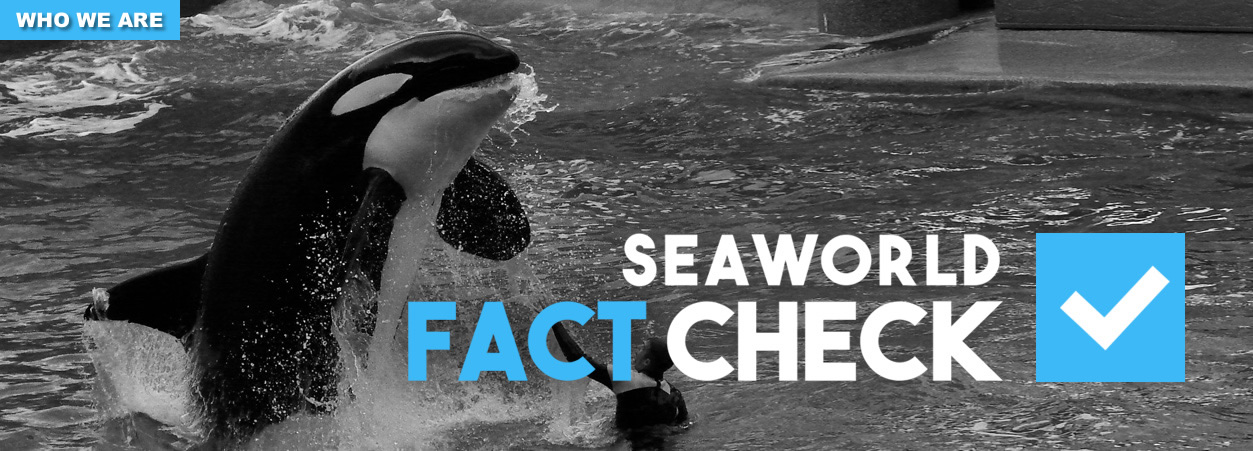SEAWORLD FACT CHECK:
SeaWorld summarily dismisses the possibility of sea pen sanctuaries with the argument that “[u]ncontrollable exposure to pollution, ocean debris and life-threatening pathogens in ocean waters are just a few of the factors that make sea pens an unhealthy living environment for any of our animals.”
SeaWorld’s park in San Diego is only a few miles from a substantial sea pen facility, housing dozens of bottlenose dolphins, operated and maintained by the US Navy Marine Mammal Program1. This sea pen facility for bottlenose dolphins is situated in San Diego Harbor. SeaWorld and the US Navy collaborate with and support each other. In addition, a number of sea pen facilities are members of the Alliance of Marine Mammal Parks and Aquariums, a professional association of which SeaWorld is a founding member2. SeaWorld’s statement in its responses to these questions is inconsistent with its acceptance of the sea pen facilities of professional associates.
SeaWorld also states that “[o]ur facilities are among the largest and most sophisticated in the world and we are committed to nearly doubling their size.” The standards for tank size were established by dolphinariums, including SeaWorld, in consultation with the US Department of Agriculture’s Animal and Plant Health Inspection Service over 30 years ago3, and are only a minute fraction of the whales’ normal range (Baird 2000). The environments offered by tanks are barren of stimuli. The fact that a portion of the captive population was born in tanks is irrelevant; housing whales in sea pens is not the same as releasing them to the wild.
The risk of exposing orcas who have been maintained for years in relatively sterile conditions is real; however, the location of any sea pen sanctuary would be selected taking water quality into careful account (see, e.g., entry under CONSERVATION). Keiko, the orca from the film Free Willy, was held for more than a decade in artificial seawater of relatively poor quality (he developed a skin condition as a result). After first being transferred to a natural seawater facility and held there for two years, during which his skin condition cleared, he was subsequently placed in a sea pen in a bay in Iceland and later Norway, without any significant challenges to his immune system over a period of more than five years (Simon et al. 2009).
References:
Baird, R.W. 2000. The killer whale. pp. 127-153. In: J. Mann, R.C. Connor, P.L. Tyack, and H. Whitehead (eds.) Cetacean Societies, University of Chicago Press: Chicago. 433 pp.
Simon, M., Hanson, M.B., Murrey, L., Tougaard, J., and Ugarte, F. 2009. From captivity to the wild and back: An attempt to release Keiko the killer whale. Marine Mammal Science 25: 693–705.
1 http://www.public.navy.mil/spawar/Pacific/71500/Pages/default.aspx
2 http://www.ammpa.org/ourmembers.html
3 http://www.aphis.usda.gov/animal_welfare/downloads/Animal%20Care%20Blue%20Book%20-%202013%20-%20FINAL.pdf
____________
SEAWORLD SAYS:
“SeaWorld prevented PETA (People for the Ethical Treatment of Animals) from submitting this question on my behalf at their shareholders meeting today… Please, tell us, when will SeaWorld allow the animals it holds captive to return to their home – the ocean – by retiring them to a seaside sanctuary?”
Hi, Kelly. We’ve double checked and the QA feature was functioning properly during the shareholder meeting — in fact others were able to submit questions. We did answer a question on sea pens today and a similar one asked by PETA at last year’s meeting.
The following is a transcript from SeaWorld CEO Joel Manby’s response to a similar question during the June 2015 stockholders’ meeting:
“First, and most importantly, our killer whales are healthy, well cared for and thriving in our care. Although animal rights critics make false allegations, there is no science to support their claims. Millions of people experience our whales annually and are inspired by them every year when they visit our SeaWorld parks. Our facilities are among the largest and most sophisticated in the world, and in California we will soon begin construction on our new killer whale habitat. This new environment, which will dramatically increase the existing size and provide more natural elements and experiences – is being built to create even greater options in their care and enrichment. It will also foster even more opportunities for the meaningful science that will help their counterparts in the wild – not to mention what we think is going to be a one-of-a-kind guest experience. More than 80 percent of our whales were born in our care and sea pens would be a poor choice for them. Uncontrollable exposure to pollution, ocean debris and life-threatening pathogens in ocean waters are just a few of the factors that make sea pens an unhealthy living environment for any of our animals.”
Why won’t SeaWorld consider moving its killer whales to sea pens?
A number of you have asked us about why we won’t consider moving our killer whales to sea pens. First, and most important, our killer whales are thriving right where they are and millions of people get to see them and be inspired by them every year. Our facilities are among the largest and most sophisticated in the world and we are committed to nearly doubling their size.
These are the environments that are home for our animals, and the environments that allow us to care for them properly. Eighty percent of our killer whales were born in human care. There are many other reasons why sea pens are a poor choice for our whales, including exposure to pollution, ocean debris and life-threatening pathogens like morbillivirus.
|

